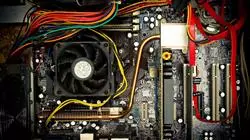University certificate
The world's largest faculty of information technology”
Introduction to the Program
IT professionals must continue their specialization to adapt to new developments in this field"

The teaching team of this Postgraduate certificate in Computer Structure and Technology will made a careful selection of each of the topics of this program in order to offer the students a study opportunity as complete as possible and always related to current events.
The program of this Postgraduate Certificate focuses on the history of computers to introduce students to arithmetic or classical concepts of logic design. The basic operation of a computer, the internal and external memory or the input and output ports, as well as the structure of the processor are key elements of this specialization. In addition, aspects such as the design and evolution of computers or the different processors will also be covered in this program.
This Postgraduate certificate provides students with specific tools and skills to successfully develop their professional activity in the broad environment of Computer Structure and Technology; it also works with key skills such as knowledge of the reality and daily practice in different IT areas and develops responsibility in the monitoring and supervision of their work, as well as specific skills within this field.
Additionally, as it is a 100% online program, the student is not constrained by fixed schedules or the need to move to another physical location, but can access the contents at any time of the day, balancing their professional or personal life with their academic life.
This Postgraduate Certificate is the best investment you can make when choosing a refresher program to get up to date with the existing knowledge of Computer Structure and Technology”
This Postgraduate certificate in Computer Structure and Technology contains the most complete and up-to-date program on the market. Its most outstanding features are:
- Development of case studies presented by experts in IT Engineering
- The graphic, schematic, and practical contents with which they are created, provide scientific and practical information on the disciplines that are essential for professional practice
- Practical exercises where self-assessment can be used to improve learning
- Its special emphasis on innovative methodologies in Computer Structure and Technology
- Theoretical lessons, questions to the expert, debate forums on controversial topics, and individual reflection assignments
- Content that is accessible from any fixed or portable electronic device with an Internet connectio
Don't miss the opportunity to study this program in Design Methodology with TECH. It's the perfect opportunity to advance your career"
The teaching staff includes a team of professionals from the field of design, who bring their experience to this specialization program, as well as renowned specialists from leading societies and prestigious universities.
Its multimedia content, developed with the latest educational technology, will provide the professional with situated and contextual learning, i.e., a simulated environment that will provide an immersive education programmed to learn in real situations.
The design of this program focuses on Problem-Based Learning, by means of which the professionals must try to solve the different professional practice situations that are presented throughout the program. For this purpose, the professionals will be assisted by an innovative interactive video system developed by renowned and experienced experts in Computer Structure and Technology.
This program comes with the best educational material, providing you with a contextual approach that will facilitate your learning"

This 100% online Postgraduate certificate will allow you to balance your studies with your professional work while increasing your knowledge in this field"
Why study at TECH?
TECH is the world’s largest online university. With an impressive catalog of more than 14,000 university programs available in 11 languages, it is positioned as a leader in employability, with a 99% job placement rate. In addition, it relies on an enormous faculty of more than 6,000 professors of the highest international renown.

Study at the world's largest online university and guarantee your professional success. The future starts at TECH”
The world’s best online university according to FORBES
The prestigious Forbes magazine, specialized in business and finance, has highlighted TECH as “the world's best online university” This is what they have recently stated in an article in their digital edition in which they echo the success story of this institution, “thanks to the academic offer it provides, the selection of its teaching staff, and an innovative learning method aimed at educating the professionals of the future”
A revolutionary study method, a cutting-edge faculty and a practical focus: the key to TECH's success.
The most complete study plans on the university scene
TECH offers the most complete study plans on the university scene, with syllabuses that cover fundamental concepts and, at the same time, the main scientific advances in their specific scientific areas. In addition, these programs are continuously being updated to guarantee students the academic vanguard and the most in-demand professional skills. In this way, the university's qualifications provide its graduates with a significant advantage to propel their careers to success.
TECH offers the most comprehensive and intensive study plans on the current university scene.
A world-class teaching staff
TECH's teaching staff is made up of more than 6,000 professors with the highest international recognition. Professors, researchers and top executives of multinational companies, including Isaiah Covington, performance coach of the Boston Celtics; Magda Romanska, principal investigator at Harvard MetaLAB; Ignacio Wistumba, chairman of the department of translational molecular pathology at MD Anderson Cancer Center; and D.W. Pine, creative director of TIME magazine, among others.
Internationally renowned experts, specialized in different branches of Health, Technology, Communication and Business, form part of the TECH faculty.
A unique learning method
TECH is the first university to use Relearning in all its programs. It is the best online learning methodology, accredited with international teaching quality certifications, provided by prestigious educational agencies. In addition, this disruptive educational model is complemented with the “Case Method”, thereby setting up a unique online teaching strategy. Innovative teaching resources are also implemented, including detailed videos, infographics and interactive summaries.
TECH combines Relearning and the Case Method in all its university programs to guarantee excellent theoretical and practical learning, studying whenever and wherever you want.
The world's largest online university
TECH is the world’s largest online university. We are the largest educational institution, with the best and widest online educational catalog, one hundred percent online and covering the vast majority of areas of knowledge. We offer a large selection of our own degrees and accredited online undergraduate and postgraduate degrees. In total, more than 14,000 university degrees, in eleven different languages, make us the largest educational largest in the world.
TECH has the world's most extensive catalog of academic and official programs, available in more than 11 languages.
Google Premier Partner
The American technology giant has awarded TECH the Google Google Premier Partner badge. This award, which is only available to 3% of the world's companies, highlights the efficient, flexible and tailored experience that this university provides to students. The recognition as a Google Premier Partner not only accredits the maximum rigor, performance and investment in TECH's digital infrastructures, but also places this university as one of the world's leading technology companies.
Google has positioned TECH in the top 3% of the world's most important technology companies by awarding it its Google Premier Partner badge.
The official online university of the NBA
TECH is the official online university of the NBA. Thanks to our agreement with the biggest league in basketball, we offer our students exclusive university programs, as well as a wide variety of educational resources focused on the business of the league and other areas of the sports industry. Each program is made up of a uniquely designed syllabus and features exceptional guest hosts: professionals with a distinguished sports background who will offer their expertise on the most relevant topics.
TECH has been selected by the NBA, the world's top basketball league, as its official online university.
The top-rated university by its students
Students have positioned TECH as the world's top-rated university on the main review websites, with a highest rating of 4.9 out of 5, obtained from more than 1,000 reviews. These results consolidate TECH as the benchmark university institution at an international level, reflecting the excellence and positive impact of its educational model.” reflecting the excellence and positive impact of its educational model.”
TECH is the world’s top-rated university by its students.
Leaders in employability
TECH has managed to become the leading university in employability. 99% of its students obtain jobs in the academic field they have studied, within one year of completing any of the university's programs. A similar number achieve immediate career enhancement. All this thanks to a study methodology that bases its effectiveness on the acquisition of practical skills, which are absolutely necessary for professional development.
99% of TECH graduates find a job within a year of completing their studies.
Postgraduate Certificate in Computer Structure and Technology
Computer structure and technology is a branch of computer science that focuses on the design, implementation and operation of computer systems. This area of study includes both the physical components of the computer, as well as the logical and functional aspects of its operation.
Computer structure refers to the way in which hardware components are organized and connected to form a fully functional system. It includes the fundamental elements of a computer, such as the central processing unit (CPU), memory, data storage, input and output devices, and data buses that connect these components.
Computer technology, on the other hand, refers to the implementation and use of software and hardware to operate the computer, controlling its components and allowing the user to interact with it. This includes operating systems, compilers, text editors, and other software programs needed to perform work on the computer.
Computer structure and technology also covers topics such as computer architecture, processor design, data communication, network and distributed system design, and performance analysis. In short, it is a fundamental discipline for understanding how computers work in all aspects, from electronics and physical components, to programming and user interaction.
The Postgraduate Certificate specializing in computer structure and technology focuses on the design, implementation and inner workings of computer systems. The main objective of the course is to provide students with the necessary knowledge to understand the inner workings of computer hardware and computer networks, as well as their design and configuration. To this end, topics such as data processing, the organization and structure of computer components, operating system architecture, computer network design, among others, are addressed.







